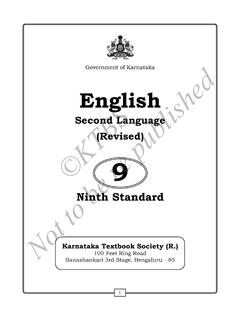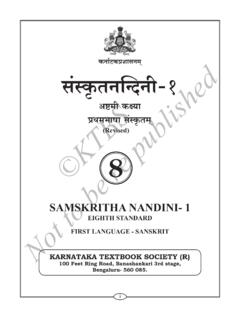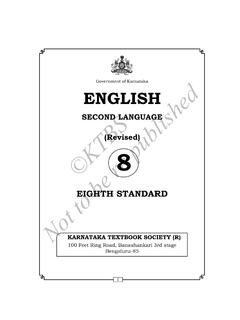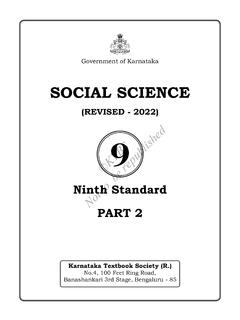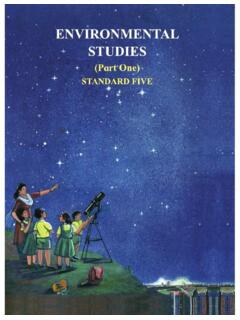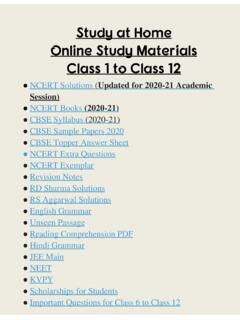Transcription of Government of Karnataka English ©KTBS
1 IEnglishFirst LanguageGovernment of KarnatakaKarnataka textbook Society (R.)100 Feet Ring Road, Banashankari 3rd Stage, BengaluruNinth Standard9(Revised) KTBS Not to be re published iiPREFACEThe textbook Society, Karnataka has been engaged in producing new textbooks according to the new syllabi which in turn are designed on NCF - 2005 since June 2010. Textbooks are prepared in 12 languages; seven of them serve as the media of instruction. From standard 1 to 4 there is the EVS, mathematics and from 5th to 10th there are three core subjects namely mathematics, science and social - 2005 has a number of special features and they are.
2 Connecting knowledge to life activities learning to shift from rote methods enriching the curriculum beyond textbooks learning experiences for the construction of knowledge making examinations flexible and integrating them with classroom experiences caring concerns within the democratic policy of the country making education relevant to the present and future needs. softening the subject boundaries-integrated knowledge and the joy of learning Making the child the constructor of knowledgeThe new books are produced based on three fundamental approaches approach, Spiral Approach and Integrated approach.
3 The learner is encouraged to think, engage in activities, master skills and competencies. The materials presented in these books are integrated with values. The new books are not examination oriented in their nature. On the other hand they help the learner in the all round development of his/her personality, thus help him/her become a healthy member of a healthy society and a productive citizen of this great country, India. KTBS Not to be re published iii The most important objectives of teaching language are listening, speaking, reading, writing and reference work.
4 These skills have been given a lot of importance in all the language textbooks. along with the inculcation of these skills, fundamental grammar, opportunities for learners to appreciate beauty and imbibe universal life values have been integrated in language textbooks. When learners master these competencies, they would stop studying textbooks for the sake of passing examinations. In order to help learners master these competencies, a number of paired and group activities, assignments and project work have been included in the textbooks. It is expected that these activities would help learner master communicative skills.
5 Ultimately, it is expected that students master the art of learning to learn and make use of these competencies in real life. The textbook Society expresses grateful thanks to the chairpersons, writers, scrutinisers, artists, staff of DIETs and CTEs and the members of the Editorial Board and printers in helping the Text Book Society in producing these textbooks. A few works of some writers and poets have been included in these textbooks. The textbook society is extremely grateful to them for giving their consent for the inclusion of these pieces in the KumarManaging DirectorKarnataka textbook Society Bengaluru, KarnatakaProf.
6 G. S. MudambadithayaCo-ordinatorCurriculum Revision and textbook Preparation Karnataka textbook Society Bengaluru, Karnataka KTBS Not to be re published ivCHAIRMAN S NOTE The textbook has been designed in accordance with the language syllabus requirements of class 9 curriculum in Kar-nataka. This book is meant for those students who have opted for English as First Language in class 9. The focus of the curriculum in general and the language syllabus in particular at this level has been on facilitating the ability to become communicatively competent, fluent, accurate and appropriate in the use of language, besides developing the ability to think differently and look at issues in the right per-spective.
7 Further, the focus has been on developing the language skills namely listening, speaking, reading and writing in an integrated manner. The reccomendations of NCF 2005 and the Karnataka Curriculum Revision Committee include the imparting of core values and ethics through language. In this background, this textbook has been designed in such a way as to realise the objectives for which the English language is taught. This book includes texts of different types for comprehension and the understanding of core values with the emphasis more on developing language proficiency, and aquiring skills for effective and meaningful communication using the target language, English .
8 The book has in all ten units and each unit consists of a prose piece and a poem for the teaching of various skills and aspects of the language. There are activities for developing and practising different skills through participation. The book also includes three supplementary lessons for developing reading comprehension and promoting extensive reading. The activities suggested are communicative in nature and are designed on the priniciples of participatory and collaborative learning. Pictorial illustrations have been given to aid comprehen-sion and to lead the learners to understand better.
9 Interractive suggestions (if any) for the improvement will be always welcome. KTBS Not to be re published vTextbook CommitteeChairperson :Dr. S. Venkateswaran, Professor, RIE, Jnanabharati Campus, :Smt. K. Parveen Taj, Asst. Teacher, Girls High School, 2nd Block, Jayanagar, Rajani Ramanath, No. 709, 1st B Main Road, 2nd Phase, 7th Block, Bangashankari 3rd Stage, Bengaluru-85 Sri Shivakumar , Asst. Teacher, Govt. High School Palace Guttahalli, North Dist, Sreenivasa Murthy .R, Shri Ganapati Composite College, Rebeeca A Salvi, Lecturer, Govt.
10 P U College, Ullagaddi, Khanapur, Hukkeri Taluk, Jayaram, Drawing Teacher, VVS High School, Rajajinagar, :Sri Narendranath G, Retired Principal, , Out House, Ashwatha Katte Road, VV Puram, Bengaluru-560004 Editorial Board MembersDr. G. Rajgopal, Professor, Dean School of English and Foreign Languages University, , Department of English , Karnataka University, Dharwad-560003,Dr. Rajendra Chenni, Professor and Head, Department of English , Kuvempu University, Shankaraghatta, Geetha Nagaraj, 29th Cross, Yadiyur, Jayanagar, Co-ordinator :Prof.
